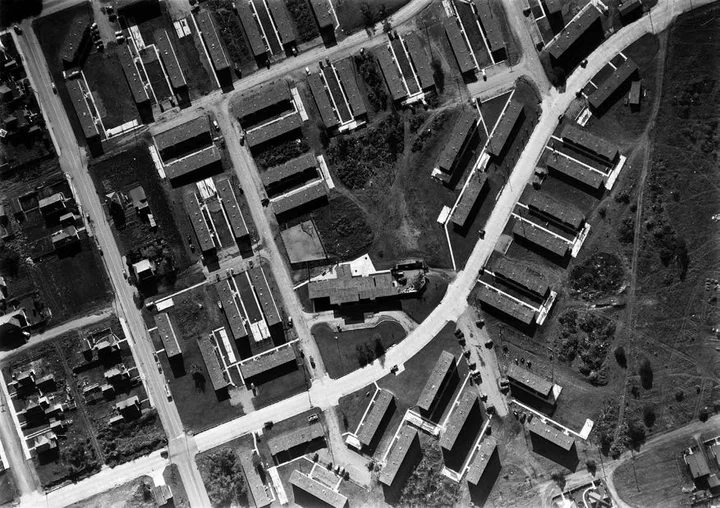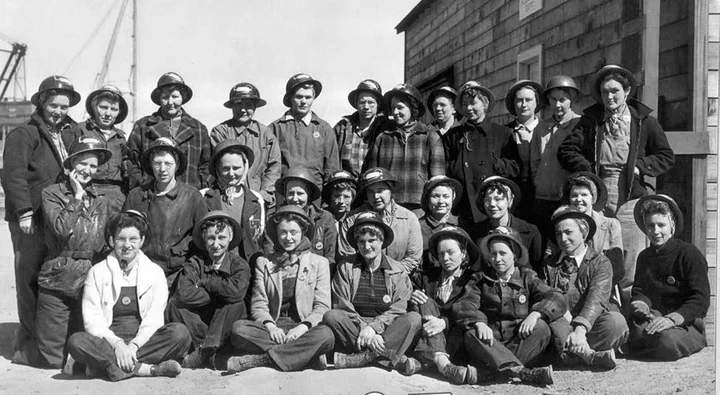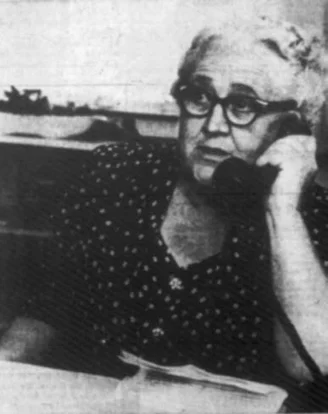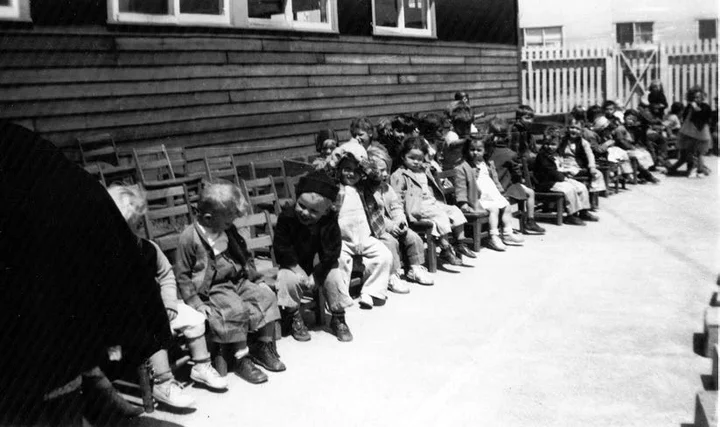The Marine View Terrace “housing project,” circa 1945. Photos via the Humboldt Historian.
Yes, there was a “housing project” where the Eureka Mall is today. When you tell this to people who were born after the late 1950s or early 60s they have no idea what you are talking about, but I remember Marine View Terrace because my family and I lived there for a few months, and I went to kindergarten there in 1958.
If you look at the newspapers over the last seventy years, you will find many conflicting accounts as to the original purpose of the housing, which was built by the Federal Housing Administration. I knew Marine View Terrace as the “housing project” — housing for low-income people, and for many of my relatives it was convenient and cheap housing near the plywood mill.
A 1958 newspaper account of the project states that it had been erected as emergency housing for returning veterans, but in a 1943 newspaper announcement stating that the Federal Housing Administration had selected the Russ-Vance land for the project, the vague term “emergency war housing” is employed. The FHA had selected a tract of twenty acres which was bounded by Harris, Henderson, Spring and Ocean streets and 320 temporary “war housing” units were to be erected and used for the duration of the war, using the Lanham Act of 1940 to appropriate federal funds to build public housing for defense industry workers — an indication that despite all the optimistic headlines about the war being over soon, the government knew that there might be a “long haul” ahead. The location of the project may have been a disappointment to local children, for those fields had been the site of much anticipated circuses over the years, and even served as a place to graze the cow of my relatives, the Hinman family. But everyone did their part for the war effort.
Women workers in their regulation duds at Chicago Bridge and Iron during the World War II years.
A hint of the real purpose of the housing is found in a human-interest story in the Humboldt Standard of March 1944, which lists among the first occupants of Marine View Terrace the Charles O’Brien family of Redding, Mr. O’Brien being a worker at the Chicago Bridge and Iron Company. Thanks to a 2005 HSU thesis for an M.S.S. degree written by Jack Bareilles — “World War Comes to Humboldt County” — I learned that Chicago Bridge and Iron was contracted by the navy to build dry docks and floating cranes to service ships during the war. According to Mr. Bareilles, it was for security reasons that the newspapers did not publicize information regarding the nature of the new work being done at the company, which might account for the later misconception that it was strictly veteran housing. The military did not want to advertise the fact that these drydocks were being built at Samoa and thereby subject the area to a potential attack by the Japanese. Even so, there were several “mentions” in early 1942 that Chicago Bridge and Iron had obtained permits and built a bridge across the slough at the foot of Washington Street, and later that buildings were quickly being constructed and that they hoped to begin welding by June 1. But after that, the mentions are few — except for the scores for the Chicago Bridge and Iron baseball team.
At one point during the war years, Chicago Bridge and Iron employed over 3000 people, around 800 being women. Fortuna High School even offered war production welding classes, which were taken by Mabel Peterson and Mary Giacomini, just two of many women who completed the class in 1943 and gained employment at Chicago Bridge and Iron. This war contract with CBI is credited with saving Eureka from becoming a “ghost town” as people left to find employment in the war industry in other locations. In fact, it is credited with dramatically increasing the population, for people liked the area and stayed on after the war.
The housing at Marine View Terrace (a name supposedly picked by the local newspapers) rented anywhere from $32.50 for a unit with no bedrooms (just a pull-down bed in the living room), to $53.00 for a three-bedroom unit that was furnished. Later, 50 units were made available to the Navy for men and their families from the Naval Air Station, the Navy Blimp Base, the Coast Guard Station, and the Naval Section Base. Also constructed were a community building with playrooms, game rooms, a clinic, a community hall, a community kitchen and a day nursery. Later a firehouse was built. These were plain, boxy, functional buildings, and certainly held no architectural interest.
In January of 1943, School Superintendent Harold Adams and a citizen’s committee applied to the War Council under the Lanham Act for a Child Care Center. The Child Care Center first opened at the First Presbyterian Church, but later the community building of Marine View Terrace became the Child Care Center. It was directed first by a Miss Meyer, with Mrs. Ruby Winzler taking over about five months later. The daycare center was a much-needed part of the war-housing complex, as both fathers and mothers were working in the defense programs. I recently met Mrs. Winzler’s daughter, Lura, and she told me that her mother had started a teaching career, but quickly decided it was not for her. She wanted to help with the war effort, though, because of the death of her son in the war, and in this way she ended up running a childcare center.
In a newspaper article published later on April 10, 1949, Mrs. Winzler describes a typical day for a child at the center:
All the children are given fruit juice and cod liver oil at 9:30 in the morning and a bountiful hot lunch at noon, and sandwiches and milk at 3:30 in the afternoon when the older ones arrive from school. The younger children have rest periods at 8:45 and 11:40 and a nap-time after lunch of one hour.
And this is where I come in. Beginning in 1958, I was one of those children at the center. I don’t really remember Mrs. Winzler, but I do remember the regimen. Cod liver oil — yuck, yuck, yuck! One time we challenged one of the new helpers to take a tablespoon herself and laughed ourselves silly over the faces she made! The cod liver oil may have been good for warding off anemia due to rationing of meat during the war, but by the time I came along we were eating meat again. I also remember those hot lunches — beans, cottage cheese and cornbread being my favorite; Swedish meatballs being my brother’s. But cooked spinach — eww — and it didn’t help to have one little girl gagging when she was forced to eat it. And nap time — I wasn’t much of a nap taker and usually spent most of the hour staring off into space. We had cots that I am sure were left over from the war. They were canvas with about six-inch legs that folded like a card table. The bigger kids got to sleep with the ends of their cots folded down, so they were at a slant — I was very jealous. Some of the kids were very restless sleepers and managed to make the legs collapse with a crash, which sent all of us into the giggles.
We always had arts and crafts — finger painting, and making stuff out of clay and popsicle sticks. There was one little boy who managed to eat more glue than he used. We also learned lots of great songs, like “She’ll be Coming ‘Round the Mountain,” “Camptown Races,” and “Dinah.” Though I could never figure out why there was someone in the kitchen with Dinah, what was a “bob-tailed nag,” and why would someone bet on the “bay” — were they racing in boats out there? I remember one lady who played the zither, which just fascinated me. Years later my mom and I had lunch with Jerrie and Bob Bartley and I found out it was Jerrie who played the zither, and that Bob later became the head of the Winzler Pre-School. Small world!
Children at the Child Care Center in the 1940s, perhaps awaiting their doses of cod liver oil. The new building already shows evidence of its proximity to the teepee burners on the bay.
Speaking of small world — our family lived for a short time in 1958 at the “Housing Project,” as it became known in the 1950s. We lived on the second floor of one unit that was fairly near the nursery school. My mom says that they paid $40 in rent and that it wasn’t bad — though I remember that the linoleum was worn down to the brown base in front of the heater. Mom said that on washday, it was always a race to see who could get to the clotheslines first. It seems odd now to think about a specific day for laundry, but on Mondays the mills would shut down the “teepee burners” so that the laundry on the lines wouldn’t get covered in soot.
At some point a chain link fence was erected between the Child Care Center and the housing project. I distinctly remember three little boys hanging on the fence chanting “Gravy, gravy, kindergarten baby” while I played on the swings. Years later when I found out that my husband’s family had lived in the project, I asked them if they ever did that, and they answered, yes, they did and that it was probably them. Not only did my future in-laws tease me, but my husband’s Aunt
Jo was assistant cook at the nursery, and my mother-in-law worked there in 1949-50 before she was married. She and her family also lived at the projects and it was there that she met her future husband, Opie, who was living there with his sister. He spotted her when she was out hanging laundry, no less.
Even though I only attended Marine View Terrace School for a year and a half, I have many vivid memories of the place, which had an impact on my family and so many other people in my life, some of whom I came to know much later.
Marine View Terrace was always meant to be a temporary measure, and at least ten years after the housing was built many people were urging the City of Eureka to demolish the structures, as they were already falling into disrepair. The Federal Housing Administration at that time was not in the business of being landlords and turned the buildings over to the state. The state in turn passed them over to the City and the Eureka Housing Authority. The units had become low-rent housing but an outcry to demolish the building continued, with the NAACP coming out against the demolition. However, the lands were either property owned by the City or private citizens, like Lloyd V. and Lucille Bridges. The buildings remained under the Housing Authority, which required that they be demolished but not sold or moved. Somehow tax liens were accrued, but the City never foreclosed or filed a deed on the properties. Ernest Pierson gained ownership of the land by redeeming the back taxes. Pierson believed at the time he was also owner of the rentals and would be receiving the rents, but the Eureka Housing Authority informed him he owned the land, but not the buildings. Ownership of the properties and buildings became a muddy legal mess and some parts ended up in litigation. Ernest Pierson, who originally was to build homes on the property, asked for a re-zoning and went on to construct the Eureka Mall on much of the property.
Meanwhile, the Eureka School District had become reluctant owners of the school buildings, which were deteriorating and unsafe. The new Lincoln School was built, which took most of the children from Marine View Terrace School, and in 1961 the school (except for the kindergarten) was closed. However, in 1962, the Child Care Center — deemed a “baby-sitting facility” by one councilman, which was “dumped into the laps” of the school district by the state — was still open and still a much needed facility in the area. Ernest Pierson, now the owner of the property, finally donated a lot situated on Henderson Street, across from the original facility, and Mrs. Winzler used her own monies to have a new childcare building constructed. It is now an accredited facility and part of the Eureka School District.
So now when you go by the Eureka Mall, you can imagine the boxy housing units and other buildings that once stood there, and once played a part in Eureka’s contributions to the war effort during the 1940s.
###
The story above was originally printed in the Summer 2014 issue of the Humboldt Historian, a journal of the Humboldt County Historical Society. It is reprinted here with permission. The Humboldt County Historical Society is a nonprofit organization devoted to archiving, preserving and sharing Humboldt County’s rich history. You can become a member and receive a year’s worth of new issues of The Humboldt Historian at this link.




CLICK TO MANAGE